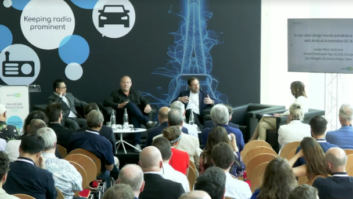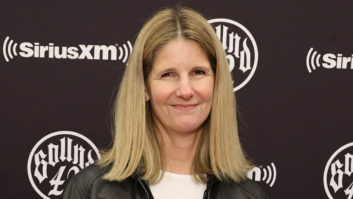Streaming, podcasts and video too: These are just some of the new business areas with which radio managers are grappling in the new digital age.
So how can you profit from the “new media” without risking financial ruin? To find out, Radio World brought together three experts, all of whom will participate in the NAB Radio Show’s “Digital Think Tank Super Session” on Sept. 23.
Peggy Miles is the session moderator and president of of Intervox Communications. Mike Agovino is CEO of the Triton Media Group and Deborah Esayian is founder/co-president of Emmis Interactive.

Mike Agovino. ‘Stop the pity party. You are not victims. You control your own attitude.’ RW: Radio’s online and new media ventures have proliferated in the recent past. What do you see as the most successful recent new media implementation for radio?
Miles: I’m starting to see life in once-dull static Web pages that now go deeper into what the DJs are doing, what the stations are doing right then and there, and adding live blog notes to home pages, plus Twitter messages, and the ability to connect in a number of ways, not just by the “contact us” page. To take the live persona to new media efforts is the next biggest challenge.
Esayian: User-generated content and listener involvement in creation of our product.
The ability to know each individual listener intimately — to have a dialog with them — to tap into their needs and involve them in shaping the experience we deliver is simply incredible. Social networks contribute significantly to this phenomenon.
Agovino: I’m not sure that I’d agree that radio’s online ventures are proliferating at this point.
Whether your evaluation is based upon actual engagement metrics or based upon revenue, the industry clearly has a long way to go … Most broadcasters are still finding their way and are trapped between gaining some understanding in using the new digital tools to their advantage and their previous tactical approach that merely reflected their on-air content to their Web site. Stations have been slow to realize that they should approach this with a different strategy, treating it as a new medium.
RW: What is the most important next step for radio stations wanting to succeed in the digital/new media realm?
Esayian: They must recognize the importance of using enterprise-level technology and have partners who keep up with advances in the digital world. They must focus on using technology to produce a superior brand experience and develop the skills to monetize what they deliver.
Miles: Those stations who will find overall consistent success understand you can assign value, ads, sponsorships, creative promotions to all that you do on any interactive platform, promotion, tool or communication. They watch trends, stories and developments happening in this space and implement them according to a risk and reward criteria. A needed skill is to be aware and be prepared.

Peggy Miles. ‘Mobile apps are hot, and rightfully so … but there is a lot of clutter out there.’ Agovino: The industry needs to shift away from the “talk” and into the “walk.” Most companies are migrating less than 5 percent of their on-air audience onto their digital platforms.
The overwhelming majority of the marketplace is still with us. We still cume 92 percent-plus of the available audience. It’s not too late. Many have the right tools in place. Let’s go!
RW: Which broadcasters are having the most success in this area and why?
Agovino: Three I would highlight from working closely with them are CBS, ESPN and Gap Broadcasting. The common traits are a significant investment made to build out platforms that are substantial; leadership that believes in the mission and leads by example; a team that is inspired to execute; models built that reward people directly for delivering the KPIs and the revenue; and a strong cultural willingness to take risks.
Miles: Success can be seen as either promotional or branding success — seen in ratings increases — or financial success. Like any akin to radio promotion that you do, it would depend on the goals of the particular station.
Look at the stations that have the most online activity and it is typically translating that they would be receiving a higher portion of the ad buys. Some stations sell applications, merchandise or music. It’s not a full-time business to do this for the majority, but there are select cases of these things working in particular cases.
Esayian: I’d like to define “success.” Success for us means running a profitable, sustainable interactive business … Every client of Emmis Interactive has made a decision that they are going to offer sophisticated, non-traditional digital solutions for their advertisers — some are experiencing interactive revenues constituting up to 14 percent of their entire station revenue, making up for the declines they are seeing on the spot side.
RW: Where do streaming, podcasts and video fit into the digital mix?
Esayian: Our findings are that streaming is more of a programming and marketing necessity vs. a great revenue opportunity.
We think will definitely change over time, but currently the advertising community struggles with valuing in-stream advertising — so if you stream you can hope to try to break even with your costs, but making streaming the lynchpin tactic of your interactive business is likely not going to be enough.
Miles: Podcasts can’t be separated out of what radio is — it’s the segments, clips, parts, pieces that make up radio. It’s an essential extension of radio, and stations should look at the resources and software outputs that allow you to put up as many podcasts as practical.

Deborah Esayian. ‘Every client of Emmis Interactive has made a decision that they are going to offer sophisticated, non-traditional digital solutions for their advertisers.’ However, make sure you track your podcasts to see what’s working, who’s downloading, when, where, how, and what type of content is of interest.
Agovino: Video is simply critical. The Web is a multi-media medium. There are affordable and simple to manage tools, Triton has one, that allow you to create/upload content to the Web, run UGC promotions and provide quality on-demand video content to the audience.
RW: What about radio and mobile platforms?
Miles: Mobile apps are hot, and rightfully so, due to their popularity, but there is a lot of clutter out there and thousands of new applications coming out daily …
Make sure your station can be heard on mobile applications. That was hard a couple of years ago, but getting easier every day. It’s great to experiment, as you don’t know which will be profitable, but perhaps the best bet is to partner now on mobile applications.
RW: Where are revenues coming from today and is this where broadcasters should spend their efforts?
Esayian: The larger-ticket campaigns are ones that involve video, interactive components like user-generated content and measurement of success.
We find that once our client stations get past the basics, they quickly get the hang of putting together very on-target, multimedia integrated campaigns with sophisticated recaps for each client showing exactly what they delivered in terms of demographics and geography.
As time has ticked on, this marketplace has become very evolved — so to compete realistically for the serious interactive dollar, you have to be able to deliver experiences online — not banners and tiles.
RW: Where will future revenue come from?
Miles: Revenues have and will continue to come from these ways, and the mix is depending on your product/service/broadcast or Internet/interactive output.
Those ways are advertising, sponsorship, subscription, referral and/or direct selling, and if you are a bigger entity, it might be developing a standalone business and spinning it off/selling it.
Esayian: Local, targeted, measurable interactive opportunities are the source of the largest growth in the interactive space and will be for some time to come.
It’s not there’s a magic solution in one area of interactive — for example, the answer to this question isn’t one singular tactic like “social networks” or “podcasting.” Rather it is having an array of interactive opportunities and capabilities to meet a variety of customer needs in many different ways.
Agovino: The holy grail is the one-to-one piece. Offering relevant information, content and messaging to individuals based upon their consumption, interest, lifestyle and attitudes is our future. Harnessing the power of that bond by inviting marketers to share in that relationship on a one-to-one level is our future.

BIA/Kelsey forecast continuing growth in the ‘digital’ local ad market. RW: Finally, what tips can you offer to a broadcast manager based on your own experiences?
Esayian: You are going to have to spend some money to have the necessary capabilities to compete effectively in a world that has evolved to a very sophisticated and advanced level already.
You must seriously educate your staff — great interactive skills and success must be cultivated with intention — broadcast managers are not born knowing how to do this correctly.
Find partners who have actually lived this experience and know how to avoid costly mistakes.
Educate your managers so they make good choices and manage their new interactive personnel intelligently.
Miles: One size doesn’t fit all. Some of your audience will never contact you, others will become heavily involved and prefer contact via phone, or tweets, or Facebook forwards, games, live events or by email.
Continue to break down your Web and interactive audiences into groups that you market to in just the way they want. Think in advance about behavior and segmentation and set up the systems accordingly. If you outsource, keep in very close contact with your suppliers or consultants, and learn from them, and ask what they are doing better than your competitors both in radio and those music sites outside of radio.
Agovino: My biggest one would be to accept responsibility and accountability for where things stand. Stop the pity party. You are not victims. You control your own attitude and the attitudes of those that work under your charge.
Be courageous, it will be infectious. People don’t care how much you know until they know how much you care. Hold yourself accountable for their development during this perfect storm. You can come out of it stronger on the other end.
The above is just as true with your audience. Be just as courageous and trusting with them … Invite them into the conversation and listen to their voices.
Interactivity is a blessing. Too many broadcasters try and convince the audience to care about what the stations wants them to care about instead of relating to the things the audience already cares about.
The “Digital Think Tank Super Session” is part of the opening address session on Wednesday Sept. 23 at 2:30 p.m. Also participating are David Goodman of CBS Radio and Paul Krasinski of Ando Media. Opening remarks are by Charles Warfield, president/COO of ICBC Broadcast Holdings, chairman of the NAB Radio Board.











